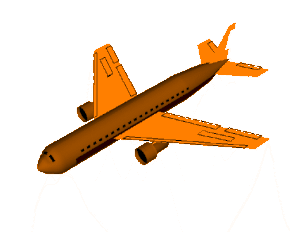Yaw axis
| Roll-Nick-Yaw angle ( Euler angle ) | |
|---|---|
| Rotation axes : | Move: |
| ↙ Longitudinal axis (roll / roll axis) : | Roll , sway |
| ↖ transverse axis (pitch axis) : | Nod, stamp |
| ↓ vertical axis (yaw axis) : | Yaw (roll) |
As a yaw axis , including high or vertical axis (engl. Yaw axis ) is referred to the vertical axis of the vehicle-based coordinate system in air , water , space or land vehicles . The rotation around this axis is called yaw . Along with swaying / rolling and nodding / pitching , yaw is one of the three basic rotational movements of a body in space.
A combination of roll, yaw and pitch is referred to as rolling .
General
The yaw rate (also yaw rate ) describes the angular speed of the rotation of a vehicle around the vertical axis. The yaw moment of inertia describes the moment of inertia about the axis. The moment about the yaw axis is called the yaw moment .
Yaw stability is the property of a vehicle to move approximately in a straight line without additional control. A vehicle that is stable against yawing shows little tendency to yaw and may even start straight ahead again without steering assistance if it has been driven off course by external influences.
Importance for the vehicle types
Aircraft
Under certain external conditions (usually gusty) yaw aircraft undesirably, which in large passenger aircraft by a yaw damper (Engl. Yaw damper ) is weakened. A special feature of aircraft is the yaw vibration ( Dutch roll ) .
- See also: flight control
Watercraft
- Yaw as a turning motion
In nautical parlance, yaw means deviating from course . Mostly as a rotation around the vertical axis, caused by swell, current or (in the case of sailing vessels) inappropriate distribution of the sail area or incorrect trim of the sails. With regard to the wind, one speaks of windward and leewardness .
A lateral displacement, for example as a result of wind or current, is not yaw, but is referred to as drift .
Land vehicles
Together with the wheel speeds and the lateral acceleration, the yaw rate is an indispensable measured variable for the function of a stability system in land vehicles. Although the yaw rate of a vehicle is one of the most important movement variables , the yaw angle only plays a very subordinate role in practice (e.g. compass for the navigation map). It is the angle between an imaginary spatially fixed and the vehicle-fixed coordinate system . In contrast, the side slip angle is much more important for driving stability.
The yaw rate of cars seldom exceeds amounts of approx. 5 ° / s on motorways and approx. 75 ° / s when parking.
The yaw moment of inertia is an important influencing variable for the "swinging" of trailers (see: anti-roll clutch ).
Track guided vehicles
In track-guided vehicles, the rolling (yawing) of the bogie caused by the sinusoidal motion is the most important factor influencing the running stability. High-speed trains therefore usually have roll dampers that are redundant.


